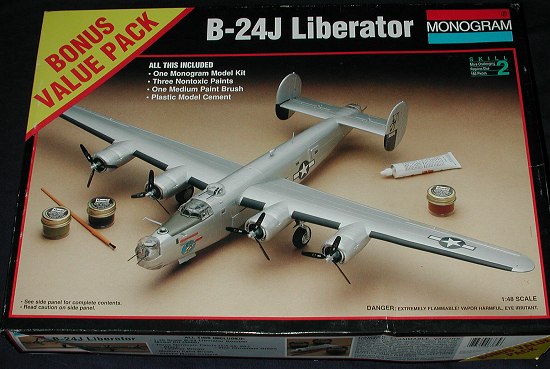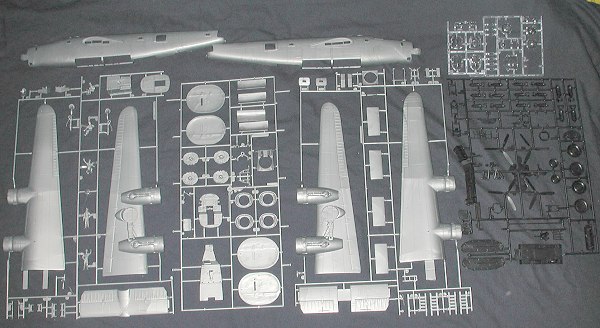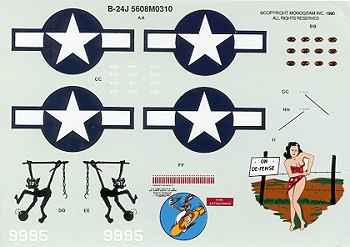
|
KIT: |
Monogram 1/48 B-24J |
|
KIT # |
6385 |
|
PRICE: |
@$30.00 when last released |
|
DECALS: |
One aircraft |
|
REVIEWER: |
|
|
NOTES: |
Swap meet kit, no paints or brushes. 1994 issue |

|
HISTORY |
Late model B-24Js were similar, but slight variations between assembly plants required repair facilities to carry up to 5 different sets of parts. The B-24J was built by Consolidated at their San Diego and Fort Worth plants, by Ford at Willow Run, Douglas at Tulsa and North American at Dallas. The B-24G-1, -H and -J models were all very similar and difficult to distinguish in some cases. Without a visible serial number, identification is almost impossible for certain subtypes. For example, Ford supplied B-24H subassemblies to Consolidated to build at their Fort Worth plant, but these aircraft were given B-24J serial numbers.
The B-24J had an improved auto pilot (type C-1) and bomb site (M-1 series). When B-24H and B-24G-1 aircraft were retrofitted with these improvements, they were redesignated as -J models which also makes absolute identification difficult. A total of 6678 were built by four companies: Consolidated, Ford, North American and Douglas
Thanks to the USAF Museum for the brief historical background.
|
THE KIT |

Another super big size bomber from Monogram. Like all the others, this one is not new and so is from the raised panel line generation. It also has the usual small problems from ejector pin marks on some of the smaller bits and a few areas with sink marks, though both of these are not that bad. To help with painting (I guess), the sprue with the props and wheels and bombs is in black plastic. The kit also comes with four crew members to use in a diorama should you wish to do so. The kit has a pretty complete cockpit with seats, control wheels and a well done instrument panel. The turrets are two part and so there will be a seam in the clear bits that will be difficult, if not impossible to remove. I'm not positive which turrets are used on this kit, but to B-24 enthusiasts, it does make a difference and will determine which markings are appropriate. I do notice that this doesn't seem to have the 'hi hat' upper forward turret fitted to many later aircraft.
The beam guns can be posed open or with covers in place. A rather full bomb
bay is provided along with enough bombs to make things interesting. The
plane will be a major tail sitter unless room can be found for quite a bit
of weight. The kit also has the very long nose pitot tubes, another telling
point for a specific version. In addition, it has a bottom turret, which
was not always fitted on non-European theater aircraft. Bomb bays can be
posed open or closed as one wishes. A tow tractor and tow bar are also part
of the kit and on the black sprue. A nice touch.
The instructions are very good as are nearly all Monogram kit instructions, with optional steps and paint colors included in each construction step. In fact, it is amazing that they could fit all the steps on the usual size of Monogram instructions. The single decal option is for an aircraft of the 380 BW during the last year of the war in the Pacific. As with most Pacific B-24s, the lower turret was probably not carried on this plane. Instead a simple Scarf ring with twin 50 cals jutting out the bottom was used in most of the 380th planes. They also added another pair of small windows just aft of the lower turret position. There is more to it and I highly recommend the book 'The Best in the Southwest' for the ultimate history on the 380BW. It is out of print and probably won't be reprinted, but it is something you should seek out if you are interested in the unit. The kit plane is in overall bare metal with an OD anti-glare panel.
|
CONCLUSIONS |
You really can't beat Monogram for doing big 1/48 bombers. These kits would never have been molded today or if so, would be so expensive that most modelers wouldn't be able to afford them. Not for the beginning modeler because of the size and probable fit concerns that most of these big planes have.
Review kit courtesy of me.
If you would like your product reviewed fairly and quickly by a site that has over 200,000 visitors a month, please contact me or see other details in the Note to Contributors.